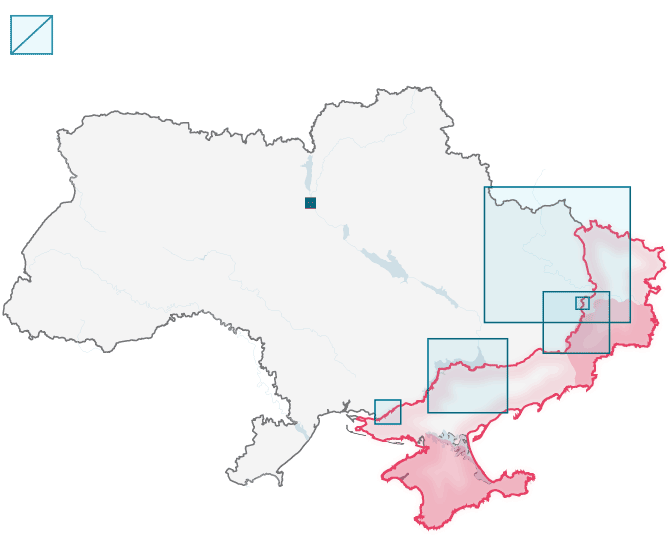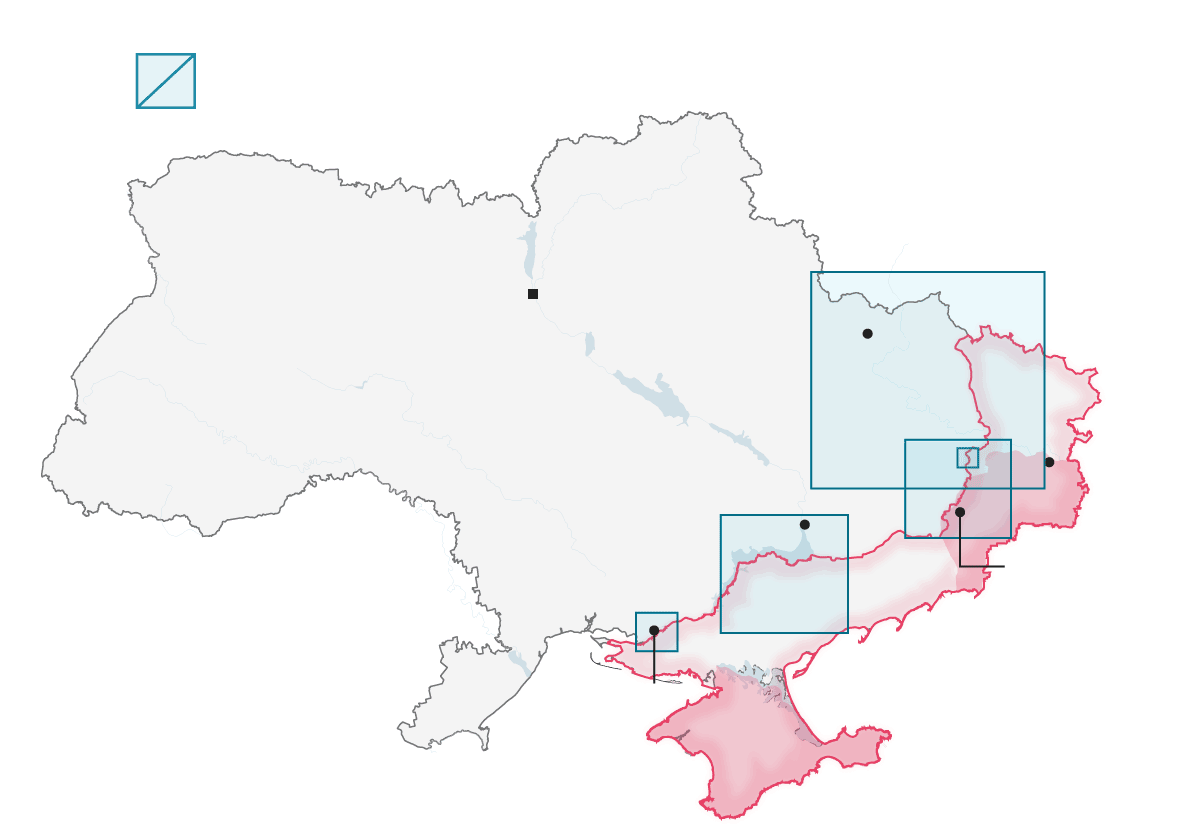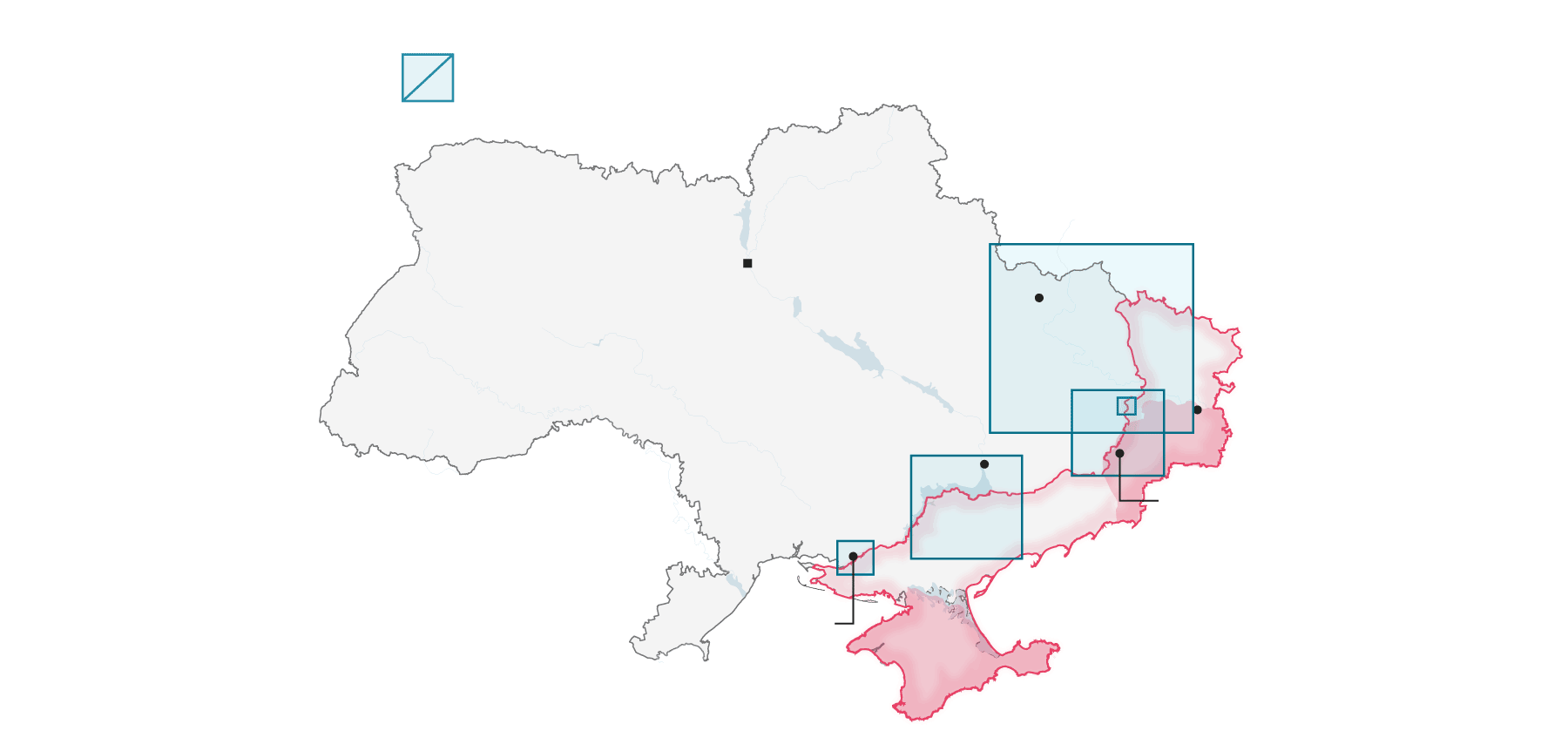Five maps explaining the possible staging points for Ukrainian counteroffensive
Kyiv’s attack to recover territories occupied by Moscow is expected to take place before mid-June along the southern and eastern front lines, where Russian forces have dug in

Zona
ocupada
por Rusia
Possible Ukrainian
counteroffensive
RUSSIA
Kyiv
5
UKRAINE
3
4
1
2
Area
occupied
by Russia

Possible Ukrainian
counteroffensive
RUSSIA
Kyiv
5
UKRAINE
3
4
1
2
Area
occupied
by Russia

Possible Ukrainian
counteroffensive
RUSSIA
Kyiv
Kharkiv
5
UKRAINE
3
Luhansk
4
Zaporizhzhia
Donetsk
1
2
Area occupied by Russia
Kherson

Possible Ukrainian
counteroffensive
RUSSIA
Kyiv
Kharkiv
5
UKRAINE
3
Luhansk
4
Zaporizhzhia
Donetsk
1
2
Area occupied by Russia
Kherson
Ukraine is aiming to mark a turning point in the course of the war with its anticipated counteroffensive to retake territory occupied by Russia. Kyiv’s strategists have said they are waiting for the end of the spring, when the weather will be drier and mud will not hinder tanks and other armored vehicles, and to receive the remaining armaments being delivered by their NATO allies. Ukraine is expected to launch its offensive in the next few weeks, according to Minister of Defense Oleksii Reznikov and advisors to President Volodymyr Zelenskiy.
In the wake of a series of sabotage operations on Russian soil and the alleged drone attack on the Kremlin, Moscow has intensified airstrikes against Ukrainian infrastructure. At the front, Russian troops have been digging a vast defensive network of trenches and fortifications that stretches from Kharkiv province to the Crimean Peninsula. According to analysts consulted by EL PAÍS and based on recent troop movements, there are five main points on the front where Kyiv could launch its counteroffensive.
Zaporizhzhia toward the Sea of Azov
Zaporizhzhia, in the southeast of the country, is one of the most promising areas for Ukraine’s counteroffensive. If the attack is staged on this flank, Ukrainian forces could attempt to reach the city of Melitopol, on the Azov Sea, to sever the territories under Russian control in two and city off supply lines between Donbas and Crimea.
According to reports from Ukrainian brigade and regional commanders, Kyiv is preparing armored battalions in this region. The Armed Forces have around 200 NATO-supplied tanks at its disposal across the entire front, but the exact details are unknown as information about deployments has been drastically reduced for the civilian population and the media.
Moscow, which controls over half of the 27,180 square kilometers that make up the province of Zaporizhzhia, has announced the evacuation of civilians from 18 localities close to the front lines. Russia also plans to evacuate at least 3,000 people from the Zaporizhzhia nuclear power plant, the largest in Europe, which it has occupied for 14 months. Most of the newly located Russian trenches are concentrated east of the Kakhovka reservoir, which separates the plant in Enerhodar from the town of Zaporizhzhia itself.
Kherson, the challenge of the Dnipro
Russian forces are also preparing for an assault in the southern region of Kherson, southwest of Zaporizhzhia along the Dnipro River, which currently acts as a natural barrier between the two armies as it passes through the city of Kherson. Ukrainian troops have been probing Russian defenses for months with a view to launching amphibious assaults against the far bank of the river.
A counteroffensive on this flank is a possibility, although a landing operation is extremely complex: the Dnipro at this point is about a mile wide, and it will be very difficult to establish a pontoon bridge without first silencing the Russian artillery. In addition, the terrain consists of marshlands, which makes the movement of armaments and heavy vehicles problematic.
The Kherson region was seized by Russia at the outset of the invasion. Kyiv recaptured the north of the province, including its capital, in a counteroffensive last November, which forced Russian troops to retreat across the Dnipro to the south. The city of Kherson is now home to only about 25% of its pre-war population of around 300,000. Pro-Russian authorities have announced evacuations in the areas of the province that remain occupied, a sign that Moscow is anticipating a possible offensive on this front.
Bakhmut, Ukraine’s fortress city
Bakhmut, in the Donetsk province, is under almost complete control of Russian forces and has become a symbol of Ukrainian resistance. The battle for the city has been the bloodiest of the war to date, and Russian losses have been significant.
One of the most visible symptoms of Russian war fatigue in Bakhmut is the growing internal battle between the Kremlin’s regular army and the Wagner Group mercenaries fighting alongside them. Yevgeny Prigozhin, the Wagner commander, has accused Russian army units of fleeing the battlefield and has launched a series of verbal attacks on the military high command, who he accuses of incompetence and of failing to supply his men with ammunition. Based on leaked U.S. intelligence documents, The Washington Post reported on May 15 that Prigozhin had made an offer to Ukraine in January to provide details on Russian positions in the area if Kyiv withdrew its forces from Bakhmut.
Meanwhile, Ukrainian troops, who control about 2.4 square kilometers of the city, have staged several counterattacks in recent days. Ukrainian Deputy Defense Minister Hanna Maliar reported that more than 10 Russian positions on the northern and southern outskirts of the city were captured last Sunday, as confirmed by the Institute for the Study of War (ISW). According to Russian sources, Kyiv’s troops advanced toward Yahidne from Berkhivka and made gains in Ivanivske, to the southwest of Bakhmut. Now, Russian forces around the besieged town, where Moscow had been launching wave after wave of attacks, have switched to a defensive stance to repel Ukrainian counter-assaults, according to the ISW.
According to the Ukrainian army’s spokesman in the region, Kyiv’s main objective in Bakhmut is to destroy Russian troop staging areas and encircle the city, without committing to frontal assaults.
Donetsk, breaking pro-Russian control
In addition to the southern front, Ukraine could launch a counteroffensive across the entire Donetsk province on the eastern to break the Russian sieges on Bakhmut, Avdiivka and Marinka. An offensive through this region would take the Ukrainian armed forces to the gates of Donetsk, the largest Russian-controlled city, which has been occupied by pro-Moscow militias or Kremlin troops since the outbreak of the Donbas conflict in 2014.
The latest ISW updates indicate recent battles in the devastated town of Marinka, further south, and Ukrainian advances along the Krasnohorivka railroad and through Ivanivske. On the other hand, Russia has recently claimed that Novopil, to the west of Vuhledar, has been taken by its troops and that its forces have made advances near Berkhivka. Across the entire Donetsk front line, Russia has been digging trenches and constructing fortifications since March, according to data from Brady Africk, an open-source intelligence researcher and analyst at the American Enterprise Institute.
After staging large-scale attacks on Ukraine’s major cities at the beginning of the invasion, Moscow has shifted its offensive efforts to concentrate on the eastern Donbas region. The Russian objective, ISW reports, is to take the whole of the Donetsk region, where the cities of Kramatorsk and Sloviansk, as well as parts of Bakhmut, remain under Ukrainian control.
Kharkiv, the gateway to Luhansk
Although the Kharkiv region in northeastern Ukraine is currently one of the least active fronts, it is also one of the possible launching areas for the Ukrainian counteroffensive, where the goal would be to drive into Luhansk. Russian sources claim that Ukrainian troops are conducting sabotage and reconnaissance operations around Kreminna, although the ISW says it has no confirmation of military activity in that area.
Russian and Ukrainian forces are engaged in a largely static struggle between Novoselivske and Kuzemivka (8 miles northwest of Svatove), and the Russian Army has established its first lines of defense along the eastern side of the railway near Novoselivske. The ISW reports that the Russian objective is to capture the remainder of the Luhansk province (which it controls almost completely) and to advance westwards, towards eastern Kharkiv and the northern part of Donetsk.
At the end of 2022, Ukraine drove the Russians out of almost the entire Kharkiv region and the western half of Kherson in a counteroffensive that was launched at several points at once. On this occasion, the analysts consulted agree that the counteroffensive will be staged on various parts of the front along with diversionary maneuvers that will force the Russian military to divert its troops and expend ammunition.
Although attention is now focused on when, where and how the counteroffensive will be carried out, Ukrainian Foreign Minister Dmitro Kuleba has sought to temper expectations about the coming operation: “Do not consider this counteroffensive as the last one, because we do not know what will come out of it,” he said. For his part, Zelenskiy has stated that Ukraine needs “a little more time” to receive all the NATO armaments. However, analysts point out the presidential announcement could be a strategy to secure the element of surprise.
Methodology
This report was made possible thanks to information provided by Cristian Segura, EL PAÍS special correspondent in Ukraine.
Data on Russian trenches comes from Brady Africk’s analysis, and the dates correspond to when they were detected by satellites; the date of construction is unknown. Russian and Ukrainian troop movements come from the Institute for the Study of War and sources consulted by this newspaper.
Sign up for our weekly newsletter to get more English-language news coverage from EL PAÍS USA Edition

